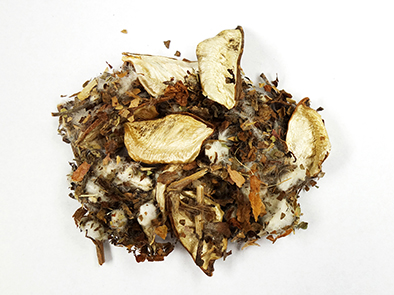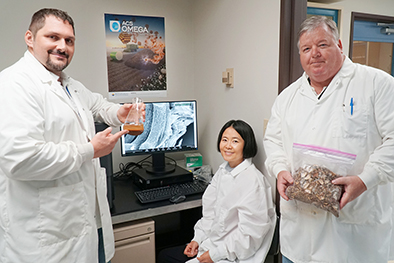Finding the “Silver Lining” in Cotton Gin Waste
Contact: Jessica Ryan
Email: Jessica.Ryan@usda.gov
April 9, 2024: Cotton gin waste, also known as cotton gin trash, is a byproduct of the cotton ginning process and occurs when the cotton fibers are separated from the seed boll. For cotton gin waste, the treasure is its hidden potential to transform silver ions into silver nanoparticles and create a new hybrid material that could be used to add antimicrobial properties to consumer products, like aerogels, packaging, or composites.
Silver nanoparticles are highly sought-after products in the nanotechnology industry because of their antibacterial, antifungal, antiviral, electrical, and optical properties. These nanoparticles have an estimated global production of 500 tons per year and are widely applied to consumer goods such as textiles, coatings, paints, pigments, electronics, optics, and packaging.

Cotton gin waste. (Photo by Sunghyun Nam)
In a study published in ACS Omega, researchers from the United States Department of Agriculture (USDA)’s Agricultural Research Service (ARS) revealed the ability of cotton gin waste to synthesize and generate silver nanoparticles in the presence of silver ions.
“Our method not only lets cotton gin waste act as chemical agents for producing silver nanoparticles, which makes it cost-effective and environmentally friendly but also enables embedding the nanoparticles within the cotton gin waste matrix,” said Sunghyun Nam, research engineer at ARS's Cotton Chemistry and Utilization Research Unit in New Orleans. “By embedding them in the cotton gin waste, these materials acquire antimicrobial properties.”
Nam said the researchers used a simple heat treatment of cotton gin waste materials in water containing silver ions that produced silver nanoparticles without the need for additional chemical agents.

Jacobs Jordan (left) shows a sample after nanoparticle synthesis, Sunghyun Nam (center) takes scanning electron microscope (SEM) images of cotton gin waste nanocomposites, and Michael Easson (right) shows cotton gin waste. (Photo by Michael Santiago Cintrón)
This finding is significant since making silver nanoparticles usually requires chemical agents which can be costly and pose environmental concerns. Embedding nanoparticles into a material can also be challenging.
Developing nanoparticle embedding technology is not new for Nam and her team. They previously developed washable antimicrobial wipes by using raw cotton fiber that produced silver nanoparticles inside the fiber. The embedded silver nanoparticles can continue to kill harmful bacteria wash after wash.
Large quantities of cotton gin waste are generated annually, and the cotton ginning industry is always seeking new sustainable processes that upcycle crop residue.
“Our research paves the way for new material applications of cotton gin waste that can protect against microbial contamination,” said Nam.
A provisional patent application on the self-embedding silver nanoparticle biomass waste compositions has recently been filed.
The Agricultural Research Service is the U.S. Department of Agriculture's chief scientific in-house research agency. Daily, ARS focuses on solutions to agricultural problems affecting America. Each dollar invested in agricultural research results in $20 of economic impact.
###
